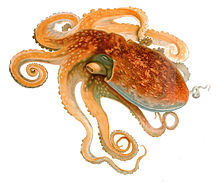Eledone cirrhosa
| Eledone cirrhosa | |
|---|---|
 |
|
| Scientific classification | |
| Kingdom: | Animalia |
| Phylum: | Mollusca |
| Class: | Cephalopoda |
| Order: | Octopoda |
| Family: | Octopodidae |
| Genus: | Eledone |
| Species: | E. cirrhosa |
| Binomial name | |
|
Eledone cirrhosa (Lamarck, 1798) |
|
The curled octopus (Eledone cirrhosa), also known as the horned octopus,lesser octopus or northern octopus, is a species of cephalopod found in the northeast Atlantic, ranging from Norway to the Mediterranean, including the British Isles.
It has a broad, ovoid-shaped mantle and can reach a total length (including arms) of up to 50 cm (20 in). The head is narrower than the rest of the body with a filament over each eye. The octopus's colour is yellowish or reddish-orange to reddish-brown dorsally with diffuse rust-brown patches, and white on the underside. The skin is covered with very fine, closely set granulations, interspersed with larger warts. The relatively short arms have a single series of suckers on them and at rest are held with the tips lightly curled, hence the species's common name.
The curled octopus is mainly found at depths between 0 and 150 m (0 and 492 ft) and may occur down to 800 m (2,600 ft). It lives in the northeast Atlantic Ocean, including the English Channel, the North Sea, and the Mediterranean Sea. In recent years the North Sea populations have increased, probably due to overfishing of large predatory fish such as Atlantic cod. This has had a knock on effect on crab and lobster fisheries as the curled octopus readily enters pots to take the bait or the catch. In seas of Scotland, E. cirrhosa is infrequently caught when trawling over rocky substrates and are more frequently captured when fishing over sandy or muddy substrates. A survey using different methods found that Eledone cirrhosa was common and widespread throughout the Scottish inshore waters covered by fishing activity, from the shoreline down to 140m, on substrates ranging through rocky, stoney, sandy and muddy. Specimens were caught throughout the year but is most common in inshore waters during the summer months and moves further offshore to the trawling grounds in October–December.
The curled octopus feeds on crabs and other large crustaceans, as well as fish.Serological analysis of the crtop contents of specimens sampled in the Moray Firth and Sound of Jura revealed the main prey to be Liocarcinus spp, Nephrops norvegicus, Cancer pagurus , Crangon crangon and Carcinus maenas, although a large proportion of the samples analysed did not react in the tests suggesting they had consumed alternative prey. It is cited as a significant predator of such commercially important species as Homarus gammarus (European lobster), Nephrops norvegicus (Norway lobster), and Cancer pagurus (edible crab) from traps. When preying on crabs, it immobilises the crab by injecting toxins into the body of the crab through a hole created in its shell using the octopus's radula. The octopus then injects saliva into the crab and the digestive enzymes contained in that saliva break down the carb's internal attachments to it shell, allowing the octopus to easily remove the carapace.
...
Wikipedia
